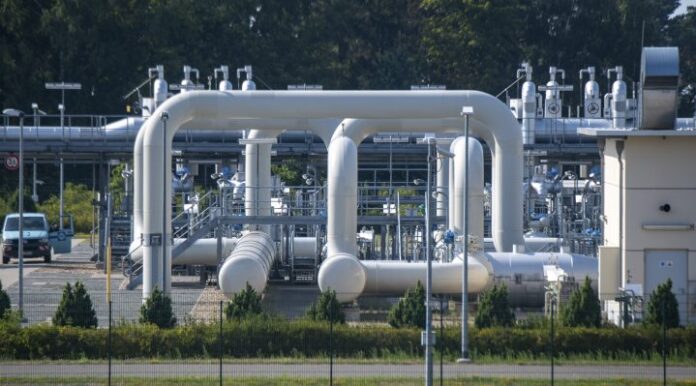Natural gas started flowing through a major pipeline from Russia to Europe on Thursday after a 10-day shutdown for maintenance – but the gas flow remained well short of full capacity and the outlook was uncertain, which leaves Europe still facing the prospect of a hard winter.
The Nord Stream 1 pipeline under the Baltic Sea to Germany had been closed since July 11 for annual maintenance work. Amid growing tensions over Russia’s war in Ukraine, German officials had feared that the pipeline _ the country’s main source of Russian gas, which recently has accounted for around a third of Germany’s gas supplies – might not reopen at all.
Network data showed gas beginning to arrive through the Nord Stream 1 pipeline as scheduled after 6 a.m., and the operator said that it had “successfully completed all planned maintenance works.” But deliveries were still far below the pipeline’s full capacity, as they were for weeks before the maintenance break.
The head of Germany’s network regulator, Klaus Mueller, said Russia’s Gazprom had notified deliveries Thursday of about 30% of the pipeline’s capacity. He later tweeted that actual deliveries were above that amount and could reach the pre-maintenance level of some 40%.
Putin questions quality of gas turbines returned by Canada
That wouldn’t be enough to resolve Europe’s energy crisis. “The political uncertainty and the 60% reduction from mid-June unfortunately remain,” Mueller wrote.
When Gazprom reduced the flow last month, it cited alleged technical problems involving equipment that partner Siemens Energy sent to Canada for overhaul and couldn’t be returned because of sanctions imposed over Russia’s invasion of Ukraine.
The Canadian government earlier this month gave permission for the turbine that powers a compressor station at the Russian end of the pipeline to be delivered to Germany.
Trending Stories
Hoover Dam explosion: A look at what’s happened so far
Truck driver in deadly Humboldt Broncos crash granted day parole for 6 months
The German government has rejected Gazprom’s technical explanation for the gas reduction, charging repeatedly that it was only a pretext for a political decision to sow uncertainty and further push up energy prices. It has said the turbine was a replacement that was only supposed to be installed in September, but that it’s doing everything to deprive Russia of the pretext to reduce supplies.
Russian President Vladimir Putin said Tuesday that Gazprom still hadn’t received the relevant documents for the turbine’s return, and on Wednesday questioned the quality of the repair work. Putin said that Gazprom was to shut another turbine for repairs in late July, and if the one that was sent to Canada wasn’t returned by then the flow of gas would decline even further.
The head of the European Union’s executive Commission, Ursula von der Leyen, said on Wednesday that the turbine was “in transit” and there was “no pretext not to deliver” gas.
‘We’re watching…a game of political chicken’: Worries rise Russia will shut off gas to Europe
Simone Tagliapietra, an energy policy expert at the Bruegel think tank in Brussels, said that Russia was playing a “strategic game.”
“Keeping low flows going is better than cutoff. It decreases Europe’s resolve to reduce gas demand,” he said. He warned that Europe must go into crisis mode anyway “because an interruption is likely to happen in the winter. And each cubic meter of gas saved now, makes Europe more resilient in the next months.”
German Foreign Minister Annalena Baerbock said “today underlines _ even if there’s an announcement that gas is flowing again _ that this war isn’t only being conducted with weapons against Ukraine, but that hybrid warfare means also using energy dependency as a means of war.”
The European Commission proposed this week that member countries cut their gas use by 15% over the coming months as the bloc braces for a possible full Russian cutoff of gas supplies.
Germany and the rest of Europe are scrambling to fill gas storage in time for winter and reduce their dependence on Russian energy imports. Germany has Europe’s biggest economy; gas is important to power its industries, provide heating and, to some extent, generate electricity.
Last month, the government activated the second phase of Germany’s three-stage emergency plan for natural gas supplies, warning that Europe’s biggest economy faced a “crisis” and winter storage targets were at risk. As of Wednesday, Germany’s gas storage was 65.1% full.
To make up for shortfalls, the German government has given the green light for utility companies to fire up 10 dormant coal-fired power plants and six that are oil-fueled. Another 11 coal-fired power plants scheduled to be shut down in November will be allowed to keep operating.
© 2022 The Canadian Press



